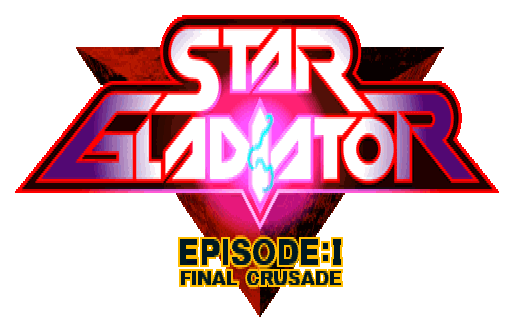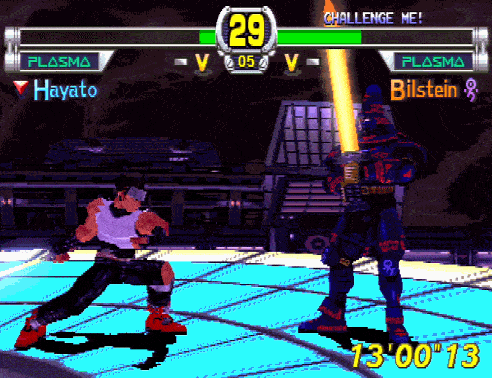Star
Gladiator Episode: I Final Crusade

STORY:
In the year
2348, humans have been exploring space for the past four centuries, and
have established contact with various alien civilizations. People now emigrate
from one planet to another, and life is generally good. In steps Edward Bilstein. A Nobel prize-winning physicist, he uncovers the secret to humanity's
"sixth sense," and discovers how to use it as an energy source he calls,
"Plasma Power."
After failed attempts to coerce other Plasma fighters to
join him in taking over Earth, Dr. Bilstein is captured by authorities
and imprisoned in a satellite orbiting planet Zeta. Six years later, Bilstein
has built himself a powerful cyborg body, and has managed to escape from
his cell, gathering a cadre of Plasma mercenaries at his side. After making
quick work of Zeta's defenses, Bilstein again sets his eyes on Earth. A
panicked Earth Federation has only one recourse: to find people who could
utilize the Plasma weapons against their own creator in a last, desperate
hope to stop the mad genius before he can invade Earth with his nascent
Fourth Empire.
|

|
|
Star
Gladiator character select screen.
|
REVIEW:
Star
Gladiator is Capcom's first attempt at a 3D fighting game, set in a futuristic Star
Wars-inspired world and presenting an entire new cast of
weapon-wielding characters. The characters
of Star Gladiator definitely resemble several well known personalities
from Star Wars, but many are considerably original designs. Similar to
Namco's Soul Blade, characters
in Star Gladiator present a unique fighting style with halfway decent animations (although
there are definitely a few awkward ones scattered about, too).
Instead of the usual 6-button layout, Star
Gladiator uses a four-button system consisting of two attack buttons that
utilize a character's weapon, a kick attack, and a guard defense. The fighters
battle in a limited 3D plane field where ring-outs (a la Soul Blade) are possible.
Characters can sidestep, however, they weirdly can't be punished with the
opponent's horizontal strikes
during a sidestep (which kinda sucks, technically-speaking). The overall gameplay speed is a bit slow, and
overall, not nearly as fine tuned or as fun to play as Capcom's trademark 2D fighting games.
Furthermore, the 3D mechanics and core gameplay of Star Gladiator
definitely pale in comparison to Namco's TEKKEN
3 (1997), released only a few short months after Star Gladiator.
|

|
|
The
dark side wins... Bilstein takes the set.
|
However, Capcom's Star Gladiator is at least playable and interesting in
some areas. Other gameplay features include "Plasma Reverses," which are defensive moves that can be performed any time during
gameplay. Another defensive maneuver "Plasma Reflect" allows players
to deflect the opponent's incoming attack and stun them, leaving them open for a
few seconds. "Plasma Revenge" enables fighters to counter an
opponent's incoming move and strike back with their own quick attack. Characters
can also use a Plasma Strike, which can cause huge damage to an opponent if it
connects on sight, but a Plasma Strike can only be done once per round.
Star Gladiator also introduces the
"Plasma Combo" System. Each fighter has his or her own combo strings,
which can be used to combo their opponent in a relentlessly, even if the
opponent is blocking. When a fighter strings together five hits they'll be able
to initiate a Plasma Final, which unleashes a powerful attack at the end of the
combo. This system was later discarded in the sequel.
|

|
|
Star
Gladiator gameplay on PS1.
|
The System
11 hardware this game ran on allowed an easy home translation to the PlayStation,
and it received a better reception on console than it did in arcades. In
retrospect, Star Gladiator
was hardly the smash hit Capcom may have hoped for. The quirky 1996 3D fighting
game would be quickly overshadowed by many others from the era. The sequel, Plasma Sword:
Nightmare of Bilstein (or Star Gladiator 2 in Japan) was ported
exclusively to the Sega Dreamcast despite much speculation of a PlayStation conversion.
 FUN FACTS:
According to former Capcom community manager, Seth Killian, Star Gladiator was originally
intended to be a Star Wars game. However, Capcom wasn't able to obtain the
Star Wars license, so they created their own characters instead. Star Gladiator was Capcom's
first in-house polygonal fighting game, as the earlier
Battle Arena Toshinden 2 was licensed to Capcom from an outside developer. FUN FACTS:
According to former Capcom community manager, Seth Killian, Star Gladiator was originally
intended to be a Star Wars game. However, Capcom wasn't able to obtain the
Star Wars license, so they created their own characters instead. Star Gladiator was Capcom's
first in-house polygonal fighting game, as the earlier
Battle Arena Toshinden 2 was licensed to Capcom from an outside developer.
|
|

| Page Updated: |
February
27th, 2025
|
| Developer(s): |
Capcom |
| Publisher(s): |
Capcom |
| Designer(s): |
Hideaki Itsuno,
Eiichiro Sasaki |
| Artwork
by: |
Bengus
Artwork / Character Design |
| Platform(s): |
Arcade, PlayStation
|
| Release Date(s): |
Oct. 25th, 1996

Oct. 31st, 1996

December
1996  |
| Characters: |
Hayato Kanzaki,
Prince, June Lin Milliam,
Gamof, Franco Gerelt,
Gore, Zelkin,
Vector,
Bilstein, Blood,
Rimgal, Kappah
|
|
|
|
Featured Video:
|
|
|
| Related Games: |
Plasma
Sword,
Star Wars: Masters of Teras Kasi, Bloody
Roar, Rival Schools: United By Fate, Street
Fighter EX, Soul Blade, Bushido
Blade, Bushido Blade 2, Marvel Vs. Capcom 2,
SNK Vs. Capcom: Card Fighters Clash,
Battle Arena Toshinden,
Battle Arena Toshinden 2,
Battle Arena Toshinden 3, Galaxy
Fight, TEKKEN 3 |
|

|
|
Gameplay
Engine
|
6.0 / 10
|
|
Story
/ Theme
|
7.5 / 10
|
|
Overall
Graphics
|
6.0 / 10
|
|
Animation
|
6.0 / 10
|
|
Music
/ Sound Effects
|
5.0 / 10
|
|
Innovation
|
6.0 / 10
|
|
Art Direction
|
8.5 / 10
|
|
Customization
|
4.5 / 10
|
|
Options / Extras
|
6.0 / 10
|
|
Intro / Presentation
|
6.0 / 10
|
|
Replayability / Fun
|
5.0 / 10
|
|
"Ouch" Factor
|
5.0 / 10
|
|
Characters
|
6.0 / 10
|
|
BOTTOM LINE
|
6.4
/
10
|
|
Review based on PlayStation
version
|
|
| Final
Words: |
Star Gladiator was an ambitious
title for the time... and a fresh take on the well-known fighting game formula by Capcom. In the realm of gameplay and overall playability, Star Gladiator didn't
live up to Capcom's most popular 2D fighting games of the late 90s. Most hardcore fighting game fans unfortunately passed on
Star Gladiator, but its character designs and overall charm would
continue to live on in various future Capcom
games.
It was interesting seeing Capcom's original artistic take on a universe comparable to Star Wars.
While Namco and other developers were beginning to develop groundbreaking 3D
fighting games in the late 90s, Capcom's attempt was respectable but still
seemed lacking on polish and overall content. Several years following Star
Gladiator, Capcom released the sequel, Plasma Sword,
which introduced new characters and improvements to the gameplay and graphics.
~TFG
Webmaster |
@Fighters_Gen
|
|
|
|
|
|
|
|
|
|
|